Lancia
|
1906 - present |
Country: |
 |
|
Development Of The Unitary Body
The majority of pre-war manufacturers,
at least those worthy of inclusion in the heritage section
of the
Unique Cars and Parts web site began with a philosophy
of building sports-cars, many with the intention of
having these cars compete on the race track.
But in
Lancia’s case, there is really only one pre-war
car worthy of mention – the remarkable “Lambda”.
Today it is widely considered as the first ever design
to feature a simple form of
unitary body/chassis construction.
The floor of the passenger compartment was so low that
a propeller-shaft tunnel had to be incorporated.
Speculation abounds as to why the engineers would develop
such an innovative method of construction, the most
favoured opinion being that their inspiration came from
the study of boat construction – the firm's founder
Vincenzo Lancia was known to have taken a boat cruise
shortly before the design.
In yet another first, the
Lambda was also the very first “large” car
to be fitted with independent front suspension, worked
by a system of coil springs on sliding pillars, all
in enclosed cylinders, and a type of hydraulic shock
absorber.
The Lambda was launched at the Paris
and London car shows of 1922, and then produced in
no fewer than nine series until 1931. The engine was
a narrow angle (13 degree) V4, with staggered bores,
and was so compact that there was also space for the
transmission to be mounted under the bonnet!
Initially
the engine capacity was 2170cc and was good for 49bhp
and a top speed of 70mph (112.6 km/h). By the time
of the third series, the engine displacement had been
increased to 2370cc, good for 59bhp and a top speed
of 77mph (124 km/h).
All car manufacturers used the same
formula of increasing engine size for subsequent models
to maintain buyer interest, and so it was that the
fifth series Lambda was fitted with a 2570cc engine
good for 69bhp and a top speed to nearly 80mph (129
km/h). Even though the Lambda was not at first intended
to be a sports-car, it had sporting characteristics.
Some 13,000 examples were built, and the car has justly
been labeled a landmark in automotive design.
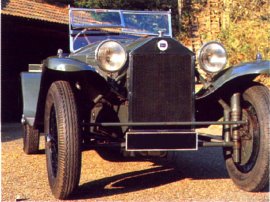
The Lambda may have been Lancia's
one and only pre-war sports car, but it is better
known for being the first car manufactured from unitary body/chassis construction.
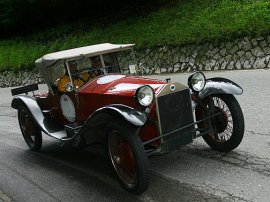
The Lambda was launched at the
Paris and London car shows of 1922, and then
produced in no fewer than nine series until
1931.
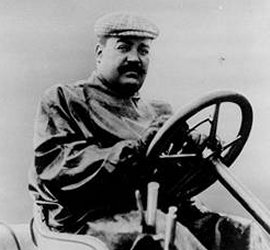
Speculation abounds as to how Vincenzo Lancia came up with the concept of
building a car from a unitary body/chassis.
The most popular theory is that his inspiration
came from boat manufacture, following his taking
a holiday cruise.
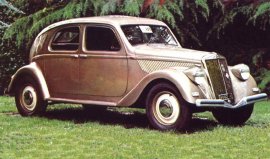
Vincenzo Lancia would pass away
in 1937 at the relatively early age of only
56, but he would leave behind him the legacy
of a very advanced small saloon model, the “Aprilia”.
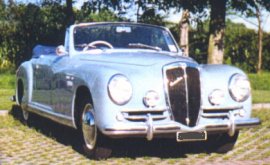
The 1950 Lancia Aurelia B50 was
the evolution of Vincenzo's legacy, the wonderful
B10.
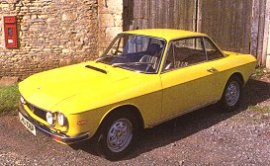
With a body by Zegato, the Lancia
Fulvia Coupes turned out to be stellar rally
cars.
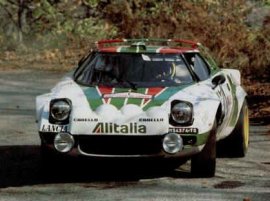
Gianpaolo Dallara's masterpiece,
the Stratos is etched into rally history.
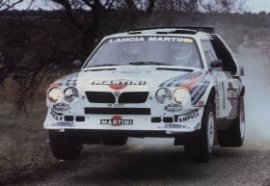
Lancia would remain committed
to WRC, although designing something as innovative
as the Stratos was always going to be difficult.
The Delta S4 would quickly silence the critics. |
Vincenzo Lancia Legacy, The Wonderful Aprilia
Vincenzo Lancia would pass away in 1937 at the relatively
early age of only 56, but he would leave behind him
the legacy of a very advanced small saloon model, the
“Aprilia”. His son Gianni would assume control
but, as was the case with the majority of European car
manufacturers, passenger car production would halt until
the end of World War 2. It was shortly after the war
that Gianni would gain the talents of ex Alfa-Romeo
designer Vittorio Jano, whom would head up Lancia's
design and research department; and it was under his
direction that the new Lancia V6 engine was developed.
The original design was a 1754cc 60-degree unit, good
for 56bhp at 4000rpm – the engine destined for
installation in their new Aurelia B10 saloon. The first
Aurelia’s were perhaps a little plain, but mechanically
they were anything but! They were of course built on
a unit-construction basis, featured Jano’s new
sweet V6 engine, were fitted with a rear-mounted transmission
in unit with the final drive, had inboard rear drum
brakes, and, lastly, offered independent rear suspension.
It was during the Aurelia period that the company's
policy toward motor sport changed; Gianni was adamant
that his company could benefit from race circuit success,
and so Lancia committed itself to developing a new breed
of sports car, one with balance, power and superior
handling.
The Pininfarina B20 GT Coupe Sets The Lancia Styling Tone
The Aurelia saloon had been launched in 1950, but a
year later the Pininfarina-styled fastback GT coupe,
the B20, was also put on sale. This was an extremely
attractive car, and would set the styling tone for Lancia,
and even some of its competitors, for many years to
come.
The B20 was originally fitted with a 1991cc 80bhp
V6 engine, perhaps not the most powerful but certainly
extremely reliable and robust, the engine would go a
long way to helping the B20 GT models achieve a second
place in the
1951 Mille Miglia, 12th place at Le Mans
in the same year, and third in the
Mille Miglia of
1952.
Later series of B20s were fitted with De-Dion rear
suspension and, given Lancia’s determination to
achieve race track success; engine capacity was increased
to 2451cc now good for 118bhp at 5000rpm. It was in
this form that the B20 would win the Liege -Rome-Liege
rally in 1953 and the Monte Carlo and
Targa Florio rallies
the following year.
Pinnafarina was commissioned to
design an open-top version of the B20, dubbed the “Aurelia
Spyder”; the first versions of the Spyder had
a rather ungainly wrap-around windscreen, but the fifth
and sixth series used a more conventional screen with
wind-up windows.
Jano Helps Lancia Develop A Grand Prix Racer
It was during the early to mid 1950’s that Lancia
embarked on more ambitious race-car designs, including
the development of a Formula 1
Grand Prix car –
all under the leadership of Jano. The first sports racer
was the D20, which had a 60 degree quad-cam V6 engine
of 2962cc good for a healthy 217bhp. Not unlike the
competition, the car used a tubular chassis frame with
independent suspension all-round, though later varieties
would use de-Dion rear ends.
By the time the D20 had evolved into the D24, it was
fitted with a much larger 3300cc V6 engine, the increased
performance helping it take out the first three places
in the Mexican road race “Carrera Pan-Americana”,
the cars being driven by racing legends such as Fangio,
Taruffi and Castellotti. The same car also tasted victory
in the Tour of Sicily, the
Targa Florio and, driven
by
Alberto Ascari, the 1954
Mille Miglia.
But development and racing of such machines is a very
costly exercise, and Lancia was starting to feel the
financial heat. By the time the factory had development
the D50
Grand Prix single-seater of 1954/55, such were
the financial woes of the company that Gianni Lancia
was obliged to hand over the cars to Ferrari, and then
sell his company to the Pesenti business interests.
Lancia Returns To Touring Car Manufacture
For the remainder of the 1950’s and following
1960’s, Lancia tried to remain viable by manufacturing
a series of technically advanced, but rather mundane
looking touring cars - notably the Appia, Flavia and
Fulvia, and although sporting derivatives of each were
produced, none qualified as an out-and-out sports-car.
Nevertheless, the lightweight Fulvia Coupes were outstanding
rally cars, and the Zagato-bodied equivalents were unmistakable,
with excellent performance and road holding.
But such cars could not stem the outward flow of capital,
and so in 1969 Lancia was taken over by Fiat. It is
somewhat sad that Gianni would lose the company founded
by his father, but as the saying goes, every cloud has
a silver lining, and so it was that Lancia would soon
benefit from Fiats ownership of Ferrari. Now Lancia
had access to the Ferrari Dino 246GT's engine and transmission
– a setup that would ultimately find its way into
the magnificent “Stratos”.
The Delta S4 Silences The Critics
The “Stratos” was designed with one objective
in mind – rallying. Gianpaolo Dallara, who had
worked for both Lamborghini and de Tomaso, is credited
with doing the majority of the development work on the
car, while the styling and structural manufacture were
completed by Bertone.
As used in the Stratos, the Dino
engine was transversely mounted behind the seats, and
was good for 190bhp at 7000, all from a reasonably small
and lightweight 2418cc engine that drive the rear wheels
through a Ferrari Dino five-speed gearbox. The Stratos
front and rear body sections could be swung completely
up and out of the way, providing access to the all-independent
suspension, and four-wheel disk brakes.
During 1974 and 1975, approximately 500 Stratos were
built to meet homologation requirements as a Group 4
competition machine, and once approved it dominated
rallying more than any other car before it. The 'works'
team won three consecutive World rally championships
- 1974, 1975 and 1976 - and in 1978, Stratos cars won
13 national and international events, all round the
world.
In the meantime, Fiat had produced a mid-engined sports
coupe which they then donated to Lancia for production;
this was the unit-construction “Monte Carlo”,
with coachwork by Pininfarina. The “Monte”
used a transverse mid-mounted twin-cam Fiat four-cylinder
engine of 1.6, 1.8 or 2.0 litres with integral five-speed
transmission.
In the USA it was known as the Scorpion
and in all markets it was sold with either a fixed roof
or roll-back 'convertible' top. The last of these cars
were built in 1983/84, after a two year lay-off in the
late 1970s to sort out
handling and quality problems.
For rallying purposes, however, the Stratos was succeeded
by the Lancia Rally coupe, which looked rather like
the Monte Carlo, but was almost entirely special except
for using that car's centre section. Only 200 were produced,
with tubular front and rear sub-frames, a longitudinal
instead of transverse engine mounting, and a supercharged
(not
turbocharged) engine.
The first car was shown at the end of 1981, the 200-off
run was completed by mid-1982, and the car started winning
events later in the year. In 1983 it distinguished itself
by winning the Monte Carlo rally, and going on to take
the World Rally Championship for Makes. In road-car
tune, the 1995cc 16-valve engine was good for 205bhp,
with up to 325bhp at 8000rpm available in fully-tuned
form.
Also see:
Lancia Car Reviews
Lancia History and Heritage (USA Edition)
Vincenzo Lancia - Legends of Motorsport (USA Edition) 


